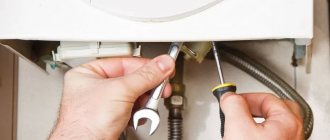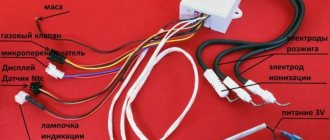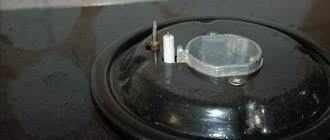Sometimes, when connecting equipment to a source of electricity, its body begins to “pinch.” Even if the discharge does not cause pain, such a malfunction should be corrected as soon as possible, since it may be a symptom of dangerous internal failures. The current strength is especially noticeable when we touch the unit with wet hands. Why does an electric stove shock?
If you encounter voltage on the surface of the electric stove, we strongly recommend that you contact a specialist for diagnostics by calling
8 (495) 228-39-35 or online. Service technicians work with refrigerators from the most popular brands: Gorenje, Indesit, Gefest, Zanussi, Hansa, Kaiser, Electrolux and others. We have been successfully repairing household appliances for more than 10 years, thanks to which all our technicians have gained enormous experience and have formed a base of regular customers. We work from 7:00 to 23:00 without weekends and holidays.
The electric stove is shocking
If you get an electric shock from the stove whenever you touch it, this definitely indicates a breakdown. It shouldn't be this way. Many users notice a weak discharge, but continue to use the tile, but even this minor problem can damage the entire device or cause a fire.
Is your stove electrocuting? You need urgent electric stove repair. Our technicians will fix any breakdown of household appliances at the client’s home. We work in all districts of St. Petersburg every day, seven days a week. You can order a specialist visit by calling 8(812)324-97-77 at any time from 7:00 to 23:00 or using the feedback form on the website. If you submit an application before 12:00, the specialist will arrive on the day of your application.
Ways to solve the problem
The operating instructions for almost any washing machine, from the Korean LG to the German Bosch, indicate the need to wipe the machine dry after each wash and leave the loading hatches open to dry the internal elements.
Unfortunately, many housewives only have enough time for such actions for a short time while the machine is new. In the future, moisture has a destructive effect on the electrical part of the unit and the insulation of the wires. Servicing your washing machine after each wash will not only extend its life, but will also significantly prevent current leakage to the body.
Grounding the washing machine
If the machine is used in a private home and there is no grounding, it must be equipped. When operating a washing unit in an apartment in an apartment building, there are two ways to prevent electric shock. Typically, apartments have two-wire wiring without protective grounding. However, there is a ground connection on the electrical panel body. In this case, you can invite a specialist from the housing office or another organization servicing the house and make a separate outlet directly from the electrical panel specifically for the washing machine. In this case, it is necessary to use a three-core cable with a grounding terminal on the shield and install a separate residual current circuit breaker.
Installation of protective shutdown
If the electrical panel also does not have grounding, the problem is solved by installing automation in the form of a residual current device (RCD). This device reacts even to minor electrical leaks and, when triggered, opens the electrical circuit, turning off the unit. An RCD cannot completely protect against electric shock, but it will definitely save lives.
The main parameter of such a protective device is the cutoff current. This is the current strength at which it turns off the device. For bathroom sockets, experts recommend installing an RCD with a cut-off current of 10 mA. The higher the risk of electric shock, the lower the cutoff current rating. For sockets in other rooms, a 30 mA automatic is suitable. A current of more than 100 mA is dangerous to human life.
You should not do the installation yourself; it is better to seek help from qualified electricians. Urgent repair of household appliances at home on the day of your call will be provided by RemonTekhnik. Competent craftsmen install an RCD after the residual current circuit breaker, and the operating current is selected to be greater than that of the circuit breaker. This is necessary so that if a short circuit occurs in the electrical network, the circuit breaker will trip earlier, protecting the RCD from burnout. Installing automatic shutdown devices in the distribution panel is not entirely convenient. When the device is triggered, you must constantly look into the panel to turn the washing unit back on. It is better to install a socket with a built-in RCD.
Another way to avoid electric shock is to install a primary and additional potential equalization system (EPS). The elements of this system are building structures, utility networks and a lightning rod system. In rooms with an increased risk of electric shock (bathrooms), additional systems are installed, consisting of a potential equalization box and conductors. It is better to entrust high-quality installation of all elements to professionals in this field.
Causes
There are several basic conditions that lead to the piezo constantly clicking on a gas stove. These include:
- water or other liquid entering the control panel or buttons that turn on the equipment;
- the buttons are filled with grease as a result of cooking;
- the control unit is closed;
- wires are burnt or melted;
- presence of dampness in the room;
- oxidation of contacts occurred.
Before you begin to troubleshoot these problems, you need to know and understand the principle of operation of electric ignition in a gas hob.
If none of the above reasons are observed, it is better not to attempt repairs on your own, but to immediately contact the experts. This will not only help you maintain your equipment and keep it in order, but will also ensure the safety of all family members in the future.
Professional repair
Conclusions and useful video on the topic
The first video contains information that will help you understand some of the causes of current leakage and understand how to deal with them:
The following video shows how you can independently detect the presence of a current leak:
The presence of a discharge on the body of the gas stove indicates that it is faulty or there are problems in the electrical network. The situation is complicated by the fact that “blue” fuel is flammable and explosive. Therefore, operation of the stove should be stopped immediately after the first signs of malfunction are identified. This will prevent accidents.
Your stove also recently experienced an electric shock, but did you successfully deal with this problem? Share your experience with other users, tell us what the problem was and how you managed to fix it - the comment form is located below this post.
Why are conductive pipes dangerous?
Even a small voltage (42 volts or more) can kill a person, depending on many factors, including:
- Painful condition.
- Diseases of the heart and blood vessels.
- Alcohol intoxication.
- Factors that enhance current conductivity.
It is difficult to say definitively what an electric shock will lead to - from a minor pinch to death.
Not only in the case of gas pipes, but also with any other pipes, wires caught on them are dangerous. During repairs in one of the apartments, a man allowed exposed wires to touch the pipeline. When he touched the heated towel rail, he was instantly electrocuted. A sad fate awaited the neighbor who came running to help and tried to save the owner of the apartment. Water from a device torn off when a man fell turned out to be an ill-fated conductor of electric current
In addition, let's not forget that electric current and gas are still a negative combination, which, under unfavorable circumstances, can cause a fire or explosion.
Installation of protective equipment
When the water from the tap shocks in the apartment, most likely you will need to install protective automation in the bathroom, since in such places electric shock occurs more often than in other rooms. Experts do not recommend installing protective automation “with a reserve”. Circuit breakers should be set to the lowest power possible to ensure a minimum flow of electricity to the devices. So, the minimum leakage current should be about 10 mA.
If there is no grounding, it is necessary to install special equipment that will provide it. All electrical devices must be connected through an RCD, which will be triggered at the moment when the current leakage begins to be 10 mA or higher. Experts also recommend installing control systems that integrate equipment into a seamless communication network. This includes a bathtub, a sink, and other objects that could potentially conduct electric current. All these devices are connected to a single grounding bus. The SUP can be not only for one apartment, but also for the entire apartment building.
Sometimes the system that is designed for a house or entrance cannot cope with the load or there is none at all. That is why installing an EMS is the most common and effective option. It is worth understanding that such actions should be performed only with the help of specialists, since inept actions can lead to disastrous consequences. You shouldn’t skimp – it’s better to invest in experienced electricians who will have the necessary knowledge and skills. The craftsmen will do all the necessary work, thereby protecting the inhabitants of the house.
Why can the electric ignition of a gas stove click?
The causes of this malfunction can be very different, but all of them do not deserve special concern and, as a rule, are easily eliminated:
- If a clicking sound is heard after washing dishes or the stove, then the reason for its appearance is moisture that has entered the electric ignition. It causes the contacts to oxidize and close the circuit.
- Carbon deposits on the ignition button and subsequent sticking of the contact
- Overheating or breakdown of the button, leading to a short circuit of the entire circuit.
- The button malfunctions due to the accumulation of grease or dirt under it.
- Water gets into the auto-ignition switch.
- Violation of the rules for operating the stove.
- Problems associated with the functioning of the electrical panel responsible for supplying electricity to the room.
- No gas supply.
If all of the above reasons do not apply to the situation that has arisen, you should not carry out repairs yourself, since only a specialist can solve the problem in this case.
How to clean injectors?
One of the reasons is clogged injectors. Because of this, the gas pressure changes and the stove will smoke. Let's look at how to clean injectors. When working on gas stoves, the first step is to turn off the gas supply. You should also check to see if the stove is hot.
To clear the blockage, you will need to remove the divider and its cover. There will be a small hole inside. Use a sewing needle to carefully clean this hole; no effort is needed. It will be enough to rotate the needle tip in the hole.
If there is dirt, it will not hurt to clean the divider with the lid. To do this, you can use a toothbrush, dish gel, and warm water. Do not clean with a nail or wire. Modern burners are made of delicate materials and will not withstand such an act of vandalism. Next, wipe the burner dry and dry it. Then (after about half an hour) they are installed in place.
Tags: , machine, ampere, beat, boiler, sconce, view, water heater, harm, house, , grounding, sign, isolate, insulation, cable, like, kilowatt, capacitor, condensation, , installation, power, voltage, nominal, connection, potential, rule, wire, , work, regulator, repair, row, network, system, resistance, means, ten, current, , installation, phase, filter, shield, electricity, electrical panel
Short circuit in the wiring of the phase and ground conductors
The fourth reason is quite rare, but this may be your case. For example, your bathroom may not have any electrical appliances at all - no washing machine, no boiler, etc. At the same time, there are no neighbors either, and you live in your own separate wooden house. All wiring is made with a three-core cable with a grounding conductor, the panel diagram is assembled according to the rules.
And yet, you still get an electric shock in the bathroom. How is this possible?
There are two reasons:
poor grounding circuit - they hammered one corner into the ground and considered this sufficient, or the contact was broken at the point of connection to the circuit
phase short circuit to the grounding conductor, in any of the wiring lines, not necessarily in the bathroom
Well, as a rule, you naturally do not have an RCD in your electrical panel. In this case, a simple circuit breaker will not turn off, since the current for it is too small.
This can happen:
as a result of screwing a self-tapping screw into the wall, when it simultaneously hits the phase and the yellow-green PE conductor
when the insulation heats up and the wires in the lighting lamp short out
Short circuit of phases and grounding conductors in a socket with a grounding contact
due to a short circuit in a regular plug. The insulation of the phase conductor is rubbed against the pressure plate. And it is usually grounded.
Don't trust cheap carriers and extension cords yet. They need to be disabled first.
And since this conductor is connected to a common grounding bus in the panel, the potential along it will spread throughout the house and apartment.
You will only feel it first of all in the bathroom, where it is humid and damp. The presence of potential is checked with a screwdriver using an indicator, and it is better to use it with a neon bulb rather than with an LED.
Theft of electricity or unscrupulous neighbors
The first and most common reason why people sin is unscrupulous neighbors. Suspicions immediately arise that they are trying to steal some electrical energy and save extra kilowatts. This may be caused by their major renovation work on the apartment and the heavy loads associated with this connection - welding machines, electric heat guns, etc.
Or in winter, when the temperature of the central heating batteries is insufficient, they very often begin to use powerful heaters and heaters. Naturally, you can try to connect all this by illegally throwing wires to the wiring in addition to the meter.
It’s true that neighbors may not always be deliberately to blame! Therefore, do not rush to immediately accuse them of stealing electricity.
In old houses with a TN-C grounding system, there is no separate grounding conductor. But many people lately still carry out wiring with three-core cables.
And on the one hand this is correct. The house will undergo reconstruction, the grounding system will change to TN-CS, and you will have everything ready. But until this moment, do not rush to connect such a conductor.
However, some, without waiting for reconstruction, simply use the risers of the nearest water supply as grounding conductors. And they immediately connect to it the very third grounding conductor. Which in turn is connected to the body of the electrical appliance.
And if the insulation of this device breaks through, then the phase will get through the pipes into the neighboring apartments.
What to do on your own
If you cannot touch the device without feeling a tingling sensation, you should not try to fix it yourself without special tools and knowledge. But there are several mandatory things that you not only can, but should do:
- Turn off the electricity. This is an ironclad rule: if you feel a blow from the device, turn off the power supply through the shield. And then figure out what happened.
- Check whether water has spilled on the device. Inspect the equipment, check the outlet. There should be no water anywhere. Wipe all parts with a paper towel and dry all parts with a hairdryer if necessary.
- Remove the plug from the socket. This should be done when the entire apartment is de-energized. Otherwise, you can get a serious discharge. When the power to the stove is turned off, you can return electricity to the house.
Call a specialist. Even if you have an A in physics, you should not repair an electrical appliance without qualifications. At best, this will void your warranty; at worst, it will lead to irreparable damage to your equipment and even a fire. You should call the master from LenByt.
Troubleshooting
If you have basic knowledge of electrical engineering, you can try to independently determine the source of current leakage. To do this, you will need a multimeter with a megohmmeter function. Diagnostics consists of several stages:
- Disconnecting the stove from the network;
- Inspection of electrical wiring insulation (if there are any exposed wires);
- Sequential shutdown of functional units (relay, thermostat) in order to find out the location of the leak. It is necessary to disconnect components until the resistance level is restored to an acceptable value;
Any manipulation with electric current poses a serious danger to life. If you do not have the appropriate experience and qualifications, call a specialist to your home who will conduct diagnostics and accurately recognize the vulnerability. Servicing electric stoves at home can only be carried out by electricians with a safety group of at least III, who know the design of electric stoves and have access to equipment with voltages up to 1000 volts.
When inspecting and servicing the electric stove, all precautions should be taken. You can inspect and replace the internal components of the stove if it is turned off and de-energized. It is prohibited to carry out any manipulations with the switched on electric stove in damp clothes or shoes, as well as barefoot and with wet hands.
Gasification of the house in stages
- They begin to gasify the house by drawing up the appropriate specifications, which are issued by the regional gas service department. According to the law, you will be provided with this documentation within 10 working days, free of charge, in order of priority;
- Next, it is necessary to draw up a project for gasified premises and buildings, and this work should be left to professionals - design bureaus with the appropriate specifics;
- Having received the specifications from the gas service, the owner of the house enters into an agreement with her to draw up a gas supply project;
- The finished project documentation is agreed upon with the technical department of the regional gas service, then an agreement is concluded for the installation of the pipeline and gas supply to the house.
Electric ignition does not work on only one burner
If you cannot turn on just one burner using auto-ignition, the first thing to check is whether the spark plug is dirty. You may have spilled something on it or the spark plug may show signs of oxidation. To clean, use WD-40 spray or simply wipe it with a sponge. Didn't help or does the candle look perfect? Then we are talking about a malfunction.
| Signs | Breaking | Repair or replacement |
| There is no spark on one burner, the electric ignition works on the rest. | Burner ignition plug faulty. The power cord that goes from the ignition unit to the candle fails: the wire itself is damaged, the contacts oxidize. |
On some stoves, when food gets on the power cord, it sticks to the frame and gets pushed through that dirt onto the frame.
It is necessary to replace the power cord along with the spark plug (as a rule, they come assembled).
If the power cord is stuck, just peel it off from the case. To do this, it is necessary to disassemble the slab and remove contamination.
In a gas stove with auto-ignition buttons built into the burner handles, there is no spark when you press the handle of one of the burners. The other burners light up as usual.
The handle of a burner with a non-functional ignition is pressed differently than others (softer, harder, etc.).
Auto-ignition button malfunction. Modern models of gas stoves of the middle and high price categories, as a rule, have ignition buttons built into the burner handle. When the button on the burner handle fails, it stops lighting, while the other burners light up normally.
Button malfunction is usually caused by mechanical damage or oxidation of the contacts.
In case of oxidation of contacts, they are cleaned. If the button mechanism is damaged, replace it.
What to do if a person is electrocuted? First aid to the victim
If you handle electrical equipment carelessly or incorrectly, you may receive an electric shock. Perhaps this is one of the most insidious injuries. Consequences after an impact can be either visible (burns, pain, disturbances in cardiac and respiratory rhythms) or invisible. But even in the absence of external factors, the threat does not become less. And we need to act quickly. The strength of the current shock depends on the number of ions and electrons moving in the conductor. Let's figure out what to do if a person is electrocuted?
Of course, in the event of an electrical injury, it is necessary to provide first aid to the victim. The main indicators of such an injury: damage to organs and systems due to electric shock. In case of death - respiratory arrest and cardiac arrest. The consequences of a severe electric shock are difficult to predict. Various disorders may occur: in the field of the cardiovascular system, central nervous system, and hearing, vision, etc. are also possible. Therefore, it is very important to know and be able to independently provide first aid to the victim.
Ground loop device
The end point of any man-made grounding system is the circuit of the main grounding conductors. It connects a system of protective conductors to the nearest aquifer, in which moisture is saturated with ions and, in fact, is an excellent electrolyte.
To ensure low electrical resistance between the overhead and the protective conductor, a sufficient contact area and low resistance of the conductors are required. The main grounding conductors are most often represented by rolled products made of grade 3 steel or metal parts of underground communications. In the latter case, the admissibility of using natural grounding conductors as such is determined by the PUE.
The grounding system can be installed by driving or installed with accompanying excavation work. In the first case, rolled metal with stiffening ribs is used: angle steel, channel, T-bar. Such products can be hammered vertically downward without deformation, and they also have a well-developed outer surface. When burying grounding, a steel sheet, strip, or, in general, any metal objects that are massive enough to exist in the soil layer for several decades can be used.
The installation of the grounding system can be done independently, however, the calculation of the number, degree of immersion and cross-section of the main electrodes must be carried out by specialists. The calculation method is based both on the type and resistivity of the soil, as well as on the location of the main circuit and its operating conditions. But you can take a simpler route: start with 3–4 electrodes that pierce the watershed by 50–70 cm, and then add them if, according to the measurement results, the contact resistance of the circuit is not low enough.
Reasons for the appearance of dangerous potential on the housing
A washing machine, dishwasher, electric water heater, microwave oven, and even a regular range hood - all of these appliances can be a potential source of danger due to the appearance of electrical potential on the body. As a rule, the consequences of an electric shock from household appliances are limited to unpleasant sensations, but there is still a risk of serious electrical injury, and therefore such phenomena must be excluded in every possible way. There are four main sources of electrical potential for household appliances:
Zero break
A broken neutral is the most dangerous problem that can occur. In this case, the dangerous potential appears on two conductors at once.
Often a break occurs due to the burnout of a zero in an apartment or panel. It is important to know! That for dangerous voltage to occur at zero in this case, it is enough for at least one of the consumers to be plugged into the outlet.
When does a person feel a charge?
In addition to synthetic materials, they are well electrified:
- amber products;
- fur items;
- human hair;
- ebonite and other types of plastic;
- paper.
In most cases, we are most likely to get electrocuted during the winter. This is no magic. It’s just that with the onset of the cold season, we increasingly wear woolen items, and there may be several of them. Another reason why we get electrocuted more often in winter is dry air. In winter it is much drier than in summer.
There is no or poor contact on the grounding, grounding in the shield
Often, even in newly built houses with 3-wire cable lines, a situation occurs when there is a small voltage within a few tens of volts on the grounding conductor, and accordingly on everything to which it is connected.
It seems that the wiring in the apartment is new, and everything is assembled in junction boxes according to the diagrams with respect to “polarity,” but electric shock occurs everywhere you don’t touch.
The explanation may be very simple. In the apartment panel, all grounding wires are collected in a heap and connected to one common bus.
But it is just neither grounded nor zeroed! The electricians simply forgot to do this. This is where all the problems come from.
Or there is a break somewhere in the main ground wire from the circuit to your panel. Check the voltage in the panel between the ground bus and the phase. It should be stable around 220V. If the voltage “floats” in absolutely arbitrary parameters, then there is clearly a break somewhere.











